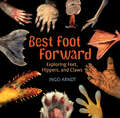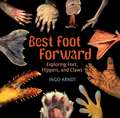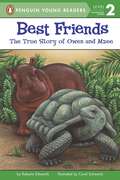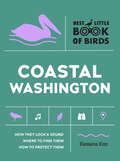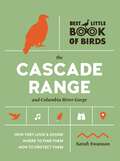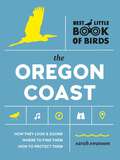- Table View
- List View
Best Enemies
by Jessica BurkhartSome Girls Just Have To Be The Best At Everything. If any two girls know about being the best, it's Heather Fox and Jasmine King. Just ask them; they'll be happy to tell you. But every girl knows that there can only be one "best." Can Sasha keep the girls from turning the arena into a war zone and still snag a spot on the coveted Youth Equestrian National Team?
Best Foot Forward: Exploring Feet, Flippers, and Claws
by Ingo ArndtWhose foot is this? An intriguing close-up of an animal's foot piques curiousity that's satisfied on the following page with a stunning full-size photo of the animal itself and a brief description of how the foot is used. A tiger stalks its prey on velvet paws. A gecko's ribbed feet enable it to climb walls as smooth as glass. The mole uses its feet for digging. The webbed feet of a duck help it swim. Rabbits and kangaroos have feet adapted for jumping fast and far. Caterpillars, starfish, and octopuses all use their feet to grab hold. The guessing-game format makes learning about natural adaptation fun. Includes an index of all animals illustrated.
Best Foot Forward: Exploring Feet, Flippers, and Claws (Into Reading, Big Book Module #3)
by Ingo ArndtNIMAC-sourced textbook <P><P>Whose foot is this? Discover the many complex kinds of feet in this exciting guessing game picture book. <P><P>The bottom of a foot is round, light brown, and looks like a spongy version of the moon. Whose foot is this? An elephant's of course! There is more to feet than walking in this fun and informative photography book about feet in the wild. Learn about the gecko's ribbed feet that enable it to climb walls as smooth as glass. Or the kangaroo, whose long flat foot is adapted for jumping fast and far. Identify the webbed foot of a duck that's perfect for swimming. <P><P>Then go into a bonus round and identify the feet of an octopus, a caterpillar, a squirrel, and much more. Crystal-clear images and informative text combine into a format that makes learning about natural adatpation exciting. <P><P>Author Ingo Anrdt is an award-winning photographer who brings this humble appendage to life. Includes an index of all animals illustrated. <P><P>Lexile Measure: NC920L
Best Friend in the Whole World
by Sandra SalsburyIn this sweet and moving picture book, debut author-illustrator Sandra Salsbury explores friendship, compassion, loss, and the transformative power of connection. Roland lives a quiet life filled with art, music, and tea parties for one. It's a nice life, but sometimes he feels rather lonely. And then one day, Roland finds the perfect companion. Milton may just be a pine cone, but they have so much in common. Milton also happens to enjoy drawing, listening to music, and drinking tea. And he's also alone. But there are signs in the woods suggesting that someone else might be missing their best pine cone friend. Suddenly, Roland doesn't know if he truly cured his loneliness or if he just passed it on to someone else.
Best Friends
by Mara BergmanDexter, Daisy and Lily are up to their usual doggy tricks causing mayhem in the park, chased by their young owners. Three mischievous mutts and a muddy stream should be a recipe for a disaster but instead these clever dogs bring everyone together. Soon dogs and children are all the best of friends!This warm and funny rhyming story celebrates the joy of playing outside and the bond between children and their pets.
Best Friends (Saddle Club #101)
by Bonnie BryantIt's almost Christmas, and The Saddle Club is busily preparing for an exciting show. But part of their preparation involves raising money -- a lot of it! When Lisa realizes that Carole and Stevie are having a hard time coming up with the cash, she takes matters into her own hands. But at the same time, Carole and Stevie are secretly plotting to help each other. Will The Saddle Club be able to fix their fund fiasco in time for the show?Meanwhile, a winter storm is brewing that may give the girls even more trouble. When things get rough, The Saddle Club must pull together more than ever, and prove that the strength of friendship can get them through even the toughest times.
Best Friends Furever (Love Puppies)
by JaNay Brown-WoodAdorable dogs + a sprinkle of magic + a celebration of social emotional learning!Yip! Yip! Hooray! A little magic can save the day!When Rosie and the rest of the Love Puppies find out that Meiko is struggling to make friends at her new school, they are sure they can sniff out a solution! But it takes more than magic to break the ice. If they can be creative, these caring canines might just might find a lonely girl her paw-fect match!With a little bit of magic and a whole lot of kindness, the Love Puppies are here to help kids overcome some tough social situations. Because with the power of love, anything is paw-sible!
Best Friends for Frances
by Russell Hoban"Today is my wandering day," says Albert when Frances invites him to play ball. And Frances is left to her own resources and her little sister Gloria, who is "not much good at all, except for crying." When Albert compounds his unreliability with a "no-girls" baseball game the next day, our high-spirited heroine acts quickly, and organizes with Gloria a "BEST FRIENDS OUTING--NO BOYS." How Frances convinces Albert of the value of her friendship and learns to appreciate Gloria while doing it will interest and amuse both children and parents. And readers who have found Frances equal to most occasions in BEDTIME FOR FRANCES, A BABY SISTER FOR FRANCES, BREAD AND JAM FOR FRANCES, and A BIRTHDAY FOR FRANCES will be pleased to see how the irrepressible little badger handles another solidly real problem.
Best Friends: (peppa Pig) (Peppa Pig Ser.)
by ScholasticA friendship-themed storybook featuring Peppa--a lovable, slightly bossy little piggy!Peppa Pig loves her best friend, Suzy Sheep. One day, Mummy Pig says that Peppa and Suzy were best friends even when they were babies! What were little Peppa and Suzy like in the olden days?Join Peppa on an adorable friendship-themed tale based on the hit Nick Jr. show--now in ebook!
Best Friends: The True Story of Owen and Mzee (Penguin Young Readers, Level 2)
by Roberta EdwardsAfter the 2004 tsunami in Southeast Asia, a little hippo named Owen was discovered orphaned and alone, far from home. Come read the true and heartwarming story of the animal sanctuary that provided a new home for Owen, where he found an unlikely best friend in a 130- year-old tortoise named Mzee.
Best Friends: The True Story of the World's Most Beloved Animal Sanctuary
by Samantha Glen"Sinjin the badly burned black cat. . .who survived to welcome others home Victor the abandoned Australian Shepherd mix. . . the capo among dogs Tyson and Tommy, two tiny black kittens. . .who had something to teach us allDiscover Best Friends A Place Where Every Animal Is Safe. . .Loved. . .And Never, Ever KilledIn the summer of 1982, a group of young men and women pooled every penny they had and bought 3,000 acres of high desert called Angel Canyon, Utah. It was to become the most famous "no--kill" animal sanctuary in the world. . .a haven for over 2000 furry and feathered friends including stiff--legged Benton who is "chairpurrson" of the TLC club. . .the infamous Goatie, comforter of horses. . .Baa Baa Ram Das, the sheep who teaches lessons. . .and Amra, the gigantic Malamute who is sheriff of Dogtown backed up by his deputy Rhonda, the tiny terrier who took one look at him and fell in love.
Best Ghost Stories
by BPI India Pvt Ltd"BEST GHOST STORIES" is collection of Creepy stories about darkness and supernatural elements! by various Authors.
Best Horse on the Force
by Sherry GarlandWhen Brandon and Wayne try to take revenge on a rookie mounted policeman who has been teasing them, their practical joke backfires and causes their favorite horse Skyjacker to be kicked off the force for cowardice.
Best Little Book of Birds Coastal Washington
by Tamara EnzThis practical, pocket-sized book is a beginner-friendly guide to the amazing birds you can find in the coastal areas of the Evergreen State. Washington&’s coast is teeming with scores of beautiful birds, and the Best Little Book of Birds: Coastal Washington will help you find them. This easy-to-use book will help you identify more than 100 commonly occurring birds that help make the Washington coast the natural wonder that it is. An emphasis on best practices and habitat sustainability help empower conservation and ensure that birding on the coast will be possible for years to come. Perfect for budding and experienced birders alike, this sleek and compact guide is the ideal travel companion for every trip to the coast.
Best Little Book of Birds The Cascade Range and Columbia River Gorge (Best Little Book Of Birds Ser.)
by Sarah SwansonEnter the amazing world of birding with this practical, pocket-sized, and beginner-friendly guide to the must-see species found in the Pacific Northwest. From the Olive-sided Flycatcher and Clark&’s Nutcracker to Barrow&’s Goldeneye and more, this easy-to-use book will help you identify the commonly occurring birds that help make the Cascades and Columbia River Gorge natural wonders. While following hiking trails and scenic byways, exploring riverside shorelines or remote forests, you&’ll learn where and when to find the most beautiful birds by their sound, appearance, habitats, and migration habits. Perfect for experienced and budding birders alike, this sleek, compact guide is the ideal travel companion for every trip to the mountains.
Best Little Book of Birds The Oregon Coast: The Oregon Coast (Best Little Book of Birds)
by Sarah SwansonA Practical, Pocket-Sized, and Beginner-Friendly Birding Guide Oregon&’s coast is teeming with scores of beautiful birds, and the Best Little Book of Birds: The Oregon Coast will help you find them. From regal ospreys and iconic eagles to frenetic sandpipers and colorful kingfishers, this easy-to-use book will help you identify more than 100 commonly occurring birds that help make the Oregon coast the natural wonder that it is. An emphasis on best practices and habitat sustainability help empower conservation and ensure that birding on the coast will be possible for years to come. Perfect for budding and experienced birders alike, this sleek and compact guide is the ideal travel companion for every trip to the coast.
Best There Ever Was: Dan Patch and the Dawn of the American Century
by Sharon B. SmithHis winning percentage was well above Jordan's shooting average or Woods's domination of golf tournaments. And he sold products and drew spectators like no one had ever done. He was hands-down the most famous athlete in America's most popular spectator sport, and exactly one hundred years ago you would have been hard pressed to find anybody in the country who didn't know his name. He was Dan Patch, and he was a racehorse. At the turn of the last century, harness racing drew larger crowds and offered bigger paychecks than any other sport. Its stars were household names, and Dan Patch was both the most celebrated and the richest. As successful as he was on the track, Dan Patch was also America's first "marketing machine": the horse who could sell cigars, washing machines, stoves, automobiles, and animal feed, just by the presence of his name and photograph. The Best There Ever Was examines the evolution of sports marketing through the lives of Dan Patch and the three men who owned him: an Indiana breeder, Dan Messner; M. E. Sturgis, who sold the horse for $20,000 (a fortune in those days) and spent the rest of his life trying to buy him back; and Marion W. Savage of Minneapolis, whose entrepreneurial skills presaged today's sports marketing geniuses.Any athlete who can draw a 90,000-person crowd, offer up world records, and then sell a coal stove with his name on it may well be the best by anybody's standards. A fun and fascinating read for sports lovers.
Best in Show: (dog Photography Book For Dog Lovers, Dog Show Photo Book)
by Dolly FaibyshevBest in Show is a collection of photographs of well-groomed and award-winning dogs by New York City–based photographer Dolly Faibyshev. The images from the Westminster Kennel Club Dog Show and beyond focus on the unique—and often humorous—relationship between each dog and their handler. Dolly Faibyshev focuses on kitsch, irony, and the larger than life human and canine characters that make up Best in Show. The result is a colorful, vibrant, campy, and satirical take on this specific slice of Americana. • The colorful, closely cropped juxtapositions of each coiffed canine contestant and their dedicated human are both humorous and charming. • Sure to delight fans of all breeds of dogs• A universal and ideal book for all canine lovers with a sense of humorBest in Show captures a specific subculture of dog devotees primarily from the infamous Westminster Kennel Club Dog Show at Madison Square Garden in New York.• A perfect book for anyone who is completely and totally obsessed with dogs and the Westminster Kennel Club Dog Show• Photographers and contemporary art lovers will also love this celebration of Dolly Faibyshev's work• Great for fans of The Dogist: Photographic Encounters with 1,000 Dogs by Elias Weiss Friedman, Dogs by Lewis Blackwell and Tim Flach, and Underwater Dogs by Seth Casteel
Best in Show: The World of Show Dogs and Dog Shows
by Bo BengtsonBo Bengtson is regarded today as the foremost international authority on dog shows past and present, and his definitive volume Best in Show: The World of Show Dogs and Dog Shows has become an "instant classic," hailed by critics around the world as the most important book ever written about the sport of dogs. Richard G. Beauchamp, a revered judge and author, praises Best in Show: "At long last a factual and meticulously researched history of the purebred dog scene. It's an everything-you-ever-wanted-to know book about the fascinating world of show dogs..." Best in Show spans the history of dog shows from its beginnings in England to the present-day, highlighting the most important dogs, shows, judges, handlers, breeders, and more in 656 pages overflowing with over 700 full-color and historical black-and-white images.Bengtson is at once a student of dog-show history, an accomplished scholar, a highly regarded international judge, a breeder of champions, and, as Kerrin Winter-Churchill surmises, "the greatest living dog writer of our times." His ultimate achievement, the award-winning Best in Show begins with a history of the dog sport, "How Dog Shows Began," a chapter that talks about the development of pure breeds, the beginnings of the dog fancy, and the first dog shows. To understand the essence of dog shows, it's critical to understand what show judges are looking for, a topic that Bengtson covers in the chapter "The Breed Standards." "Without breed standards, dog shows could not exist. It would be impossible to conduct any meaningful comparison of dogs without universally accepted descriptions of each breed.... At their best, the standards...give a vivid, colorful word picture of the image each breed represents, in motion and standing, when alert and at rest." With illustrations from early and modern breed standards, this chapter discusses the evolution of the standards and addresses the variations in certain breed standards from country to country.The third chapter is devoted to dog shows and highlights the most important shows in Britain and the United States. A detailed discussion of England's most famous dog show, Crufts, begins with the origins of the show and traces its development through the 21st century. (A complete roster of the winners of Crufts is presented in the appendix of the book.) America's most highly regarded show, the Westminster Kennel Club is discussed, accompanied by many photographs of the show and its Best in Show winners. (Roster of WKC winners can also be found in the appendix.) Bengtson also discusses other premiere shows in the U.S. including Santa Barbara, Morris & Essex, AKC/Eukanuba as well as the Fédération Cynologique Internationale's annual event, the World Dog Show. The following chapter discusses specialty shows (shows for one breed or one group), addressing the importance and purpose of specialty shows as well as some of the anomalies of certain breed events. The chapter also highlights some top winners as well as America's most famous group specialty show, the Montgomery County Kennel Club's terrier classic.Separate chapters are dedicated to the judges, breeders, and handlers who have made their mark on the sport of purebred dogs. International in scope, each chapter highlights the most accomplished individuals in the sport, summarizing their accomplishments and their special areas of expertise. The chapters also explain what's required to become a professional in the sport. The historical photographs in these chapters do a splendid job of spotlighting the careers of some of the pillars of the sport, including Anne Rogers Clark, Geraldine Rockefeller Dodge, Anna H. Whitney, Alva Rosenberg, Louis Murr, Anna Katherine Nicholas, Percy Roberts, Robert and Jane Forsyth as well as many contemporary greats such as Peter Green, Maxine Beam, Corky Vroom, Patricia Craige-Trotter, Jimmy Moses, David Fitzpatrick, Sylvia Hammarström, Roger Rechler, Julia Gasow, and dozens of others.The author devotes individual chapters to the greatest dogs from Britain, the United States of America, and...
Best in Snow: An Andy Carpenter Mystery (An Andy Carpenter Novel #24)
by David RosenfeltIn this Christmas mystery, lawyer Andy Carpenter and his golden retriever, Tara, are on the beat after a body turns up in the snow and a journalist is the prime suspect.Christmas has come early to the town of Paterson, New Jersey, in the form of a snowstorm that dumps two feet of snow on the ground. Lawyer Andy Carpenter likes snow – white Christmas and all that – but it can cause problems for the walks he takes his dogs on every day.When Andy’s golden retriever, Tara, goes to play in the snow and instead discovers a body, Andy ends up on the phone with the local newspaper editor. The murder victim is Mayor Alex Oliva, who had an infamous relationship with the newspaper. Last year a young reporter published an expose, and Oliva had him fired for libel. Now, the young reporter – and prime suspect – is in need of a lawyer.Andy agrees to take the case, though it’s not looking good this holiday season. The evidence is piling up faster than the snow in Best in Snow, the next Christmas mystery in the bestselling Andy Carpenter series from David Rosenfelt.
Best of Friends (Puppy Patrol #17)
by Jenny DaleSpangle, Ludo, and Yap are inseparable -- best friends in a houseful of mischievous mutts. And when their owner needs help, she calls on King Street Kennels to sort out her canine chaos. Neil's never seen so many dogs in one house! But unless he acts quickly, these loyal friends may have to be separated. Being in the doghouse could be Neil's greatest challenge yet!
Beth's Snow Dancer (Little Women Journals)
by Charlotte Emerson Louisa AlcottAs the family prepares for Christmas, Beth befriends a beautiful but sickly pony that strays into the March's yard and tries to keep it from being taken to Boston to be sold as a "useless beast."
Bethany Hamilton: Follow Your Dreams!
by Michael SandlerSince she was a young girl in Hawaii, Bethany Hamilton dreamed of becoming a professional surfer. Yet those dreams nearly vanished when a shark tore off her left arm. In Bethany Hamilton: Follow Your Dreams!, young readers will follow Bethany's recovery from the devastating shark attack as she retakes the surf and waves. Full-color photographs, timeline, and a compelling biographical narrative will engage readers as they learn how Bethany overcame the greatest challenges of her young life. Bethany Hamilton is part of Bearport's Defining Moments: Overcoming Challenges series.
Betsy Who Cried Wolf
by Gail Carson LevineAny wolf who tries to eat Betsy's sheep had better watch out. But Zimmo is no ordinary wolf--he's a hungry wolf, with a Plan!
Betsy Who Cried Wolf
by Gail Carson LevineOn her eighth birthday Betsy takes the Shepherds' Oath and is determined to be the best shepherd in Bray Valley history. Any wolf who tries to eat her sheep had better watch out. But Zimmo is no ordinary wolf—he's a hungry wolf, with a plan!In her first picture book, Newbery Honor author Gail Carson Levine puts her own spin on a traditional tale, while Scott Nash brings a comic sensibility to this hilarious retelling. The result will tickle, delight, and even leave readers with a moral or two, or three....

